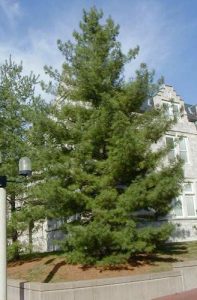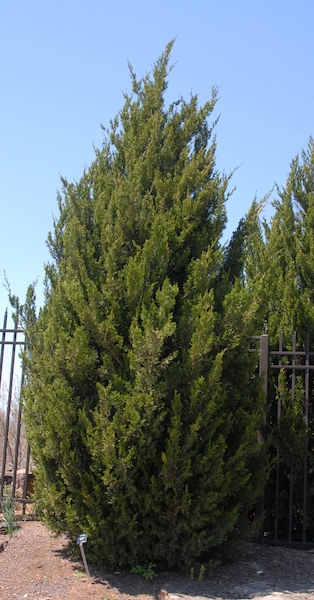Selecting Conifers for Landscape Screening
Part 2: Pines, Junipers and Planting Guidelines
By Elaine Pugh, Fairfax Master Gardener

White Pine
In this second part of our series on Selecting Conifers for Landscape Screening, pines and junipers are also recommended as excellent choices of plant material. Pine trees prefer full sun, but will tolerate some shade, and can be used as a windbreak. A number of varieties can be used in Virginia for screening, although they do not hold their lower foliage at maturity and are susceptible to a number of insects and diseases. Three of them are as follows.
Eastern white pine Pinus strobus grows 50 to 80 feet (15-24 m) in height with a spread of 20 to 40 feet (6-12 m) and long needles in bundles of five with cones 3 to 7 inches (7-18 cm) long. It prefers fertile, moist, well-drained soils, but has been found in the extremes of dry, rocky ridges and wet bogs. P. strobus creates a screen with a soft, filtered light.
Japanese red pine Pinus densiflora grows 40 to 60 (12-18 m) feet in height with a similar spread and needles in bundles of two and cones 2 to 3 inches (5-7 cm) long. It has an unusual bonsai-type look and prefers acidic, well-drained soil.
Virginia pine Pinus virginiana grows 15 to 40 feet (5-12 m) in height with a spread of 10 to 30 feet (3-9 m) and needles in bundles of two and cones 1-1/2 to 3 inches long (4-7 cm). P. virginiana is not very ornamental, but it can tolerate difficult soils. It grows on heavy, clay soil where few other plants will grow and on poor, dry soil. It prefers full sun. It is also known as scrub pine.

Rocky Mountain Juniper
The Juniperus species provide the most variety of the conifers in terms of size, especially for small yards, and in available foliage colors. Junipers provide the most soil tolerance of these evergreen screening plants. They withstand dry poor soils, and they do not like wet, poorly drained soil. They need full sun for best development and can be used as a windbreak. In addition, junipers are considered to be less deer palatable. The most common types of junipers are eastern red cedar Juniperus virginiana, Chinese juniper Juniperus chinensis and Rocky Mountain juniper Juniperus scopulorum.
Eastern red cedar Juniperus virginiana is a native tree, the largest of these junipers in size, 40 to 50 feet (12-15 m) in height with a spread of 8 to 20 feet (2-6 m). It is densely pyramidal with sharp awl-like needles when young and is slightly pendulous with scale-like needles at maturity, with cones that look like blue berries. It is tolerant of adverse conditions in a wide range of soils — poor gravelly soils, acid and alkaline soils, and has good drought tolerance. J. virginiana prefers a sunny, airy location. ‘Glauca’ is a narrow, silver-blue cultivar. Do not plant it near apple trees as it may cause cedar-rust disease on the apple fruit.

Chinese Juniper
Chinese juniper, Juniperus chinensis has numerous cultivars of different heights, widths, colors and interest. The cones are berry-like and whitish blue turning brown. It prefers moist, well-drained soils, is tolerant of calcareous soils and is pH adaptable. It prefers full sun. The cultivar ‘Torulosa’ is narrow with twisted branches. ‘Robusta Green’ is an upright narrow cultivar 15 feet (5 m) tall with blue green foliage.
Rocky Mountain juniper Juniperus scopulorum also has many cultivars of different heights, widths, colors and interest. ‘Skyrocket’ in one example which is narrow and blue in color. In addition to other soil tolerations, J. scopulorum also withstands drought conditions.
Now that you know what you want to plant, it is important to note that planting an evergreen screen comes with some temptations that should be avoided. It is tempting to plant evergreens for a screen too close together to start. Remember that these plants will grow. You don’t want them to crowd each other out when they get larger. One suggestion is to plant shrubs to fill in the areas between the screening trees as a temporary measure to provide time for trees to reach mature sizes. Staggering the row also helps.
You also should not plant the same conifer type in a single line along an entire property line. An extensive evergreen screen length should have variety in plantings to keep any disease or insect pest that may be attacking one of the trees in your screening area from wiping out the whole row before you can get it under control.
Don’t plant the trees too deeply in the ground. Most can be easily killed by water standing around their roots. It may be preferable to plant them with the root ball 1 or 2 inches (2-5 cm) higher than it grew in the nursery. Dig the planting hole twice the diameter of the root ball. Then backfill with existing soil or good topsoil. Do not add peat moss or other organic material in the planting hole as this will hold too much moisture, especially if the soil is poorly drained already.
With good choices in conifers available for screening and the knowledge of how to avoid the planting temptations, you, too, can have a healthy conifer screen.
References
• Manual of Woody Landscape Plants, by Michael A. Dirr
• Home Grounds and Animals, 2021 Pest Management Guide, Table 8.2 — Ornamental plants less
palatable to deer
• Screening, Bonnie Appleton, Elizabeth Baine, Roger Harris, Kathy Sevebeck, Dawn Alleman and
Lynette Swanson, Virginia Cooperative Extension, Publication 430-025
• Selecting Landscape Plants: Conifers, Diane Relf, and Bonnie Appleton, Virginia Cooperative
Extension, Publication 426-605
• Screening with Evergreens, Mary Morgan Arrington, updated by Sam Lusk, North Carolina
Cooperative Extension, Wilkes County Center
• Using Trees and Shrubs for Privacy and Wind Screening, Emelie Swackhamer and Jim Sellmer, Penn
State Extension
• Climatic Wind Data for the United States, National Climatic Data Center, (showing data on winter
winds from the NW for Quantico, VA)
• Juniperus chinensis and Pinus strobus, Missouri Botanical Garden Plant Finder
• Juniperus chinensis, Juniperus scopulorum, xHesperotropsis leylandii and Juniperus virginiana, North
Carolina State Garden Toolbox
• Juniperus virginiana, Alex Niemiera, Virginia Cooperative Extension, Pub 3010-1477
• Juniperus chinensis, Alex Niemiera, Virginia Cooperative Extension, Pub 3010-1469